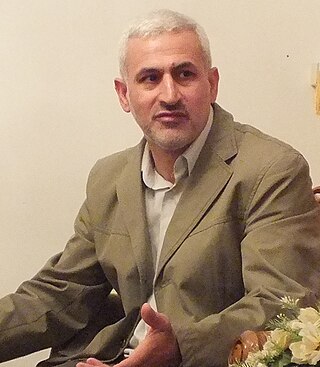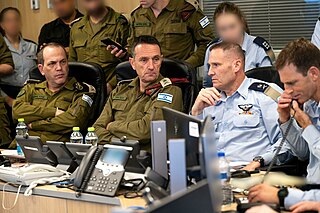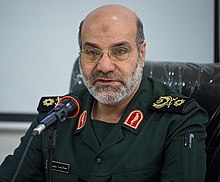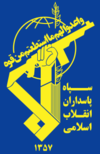
The Islamic Revolutionary Guard Corps, also called Sepah or Pasdaran, is a multi-service primary branch of the Iranian Armed Forces. It was officially established by Ruhollah Khomeini as a military branch in May 1979, in the aftermath of the Iranian Revolution. Whereas the Iranian Army protects the country's sovereignty in a traditional capacity, the IRGC's constitutional mandate is to ensure the integrity of the Islamic Republic. Most interpretations of this mandate assert that it entrusts the IRGC with preventing foreign interference in Iran, thwarting coups by the traditional military, and crushing "deviant movements" that harm the ideological legacy of the Islamic Revolution. Currently, the IRGC is designated as a terrorist organization by Bahrain, Saudi Arabia, Sweden and the United States.

The Quds Force is one of five branches of Iran's Islamic Revolutionary Guard Corps (IRGC) specializing in unconventional warfare and military intelligence operations. U.S. Army's Iraq War General Stanley McChrystal describes the Quds Force as an organization analogous to a combination of the CIA and the Joint Special Operations Command (JSOC) in the United States. Responsible for extraterritorial operations, the Quds Force supports non-state actors in many countries, including Hezbollah, Hamas, Palestinian Islamic Jihad, Yemeni Houthis, and Shia militias in Iraq, Syria, and Afghanistan. According to Michael Wigginton et al., the Al-Quds Force is "a classic example of state-sponsored terrorism."

The Iranian Armed Forces, officially the Islamic Republic of Iran Armed Forces, are the combined military forces of Iran, comprising the Islamic Republic of Iran Army (Artesh), the Islamic Revolutionary Guard Corps (Sepah) and the Law Enforcement Force (Faraja).

Qasem Soleimani was an Iranian military officer who served in the Islamic Revolutionary Guard Corps (IRGC). From 1998 until his assassination by the United States in 2020, he was the commander of the Quds Force, an IRGC division primarily responsible for extraterritorial and clandestine military operations, and played a key role in the Syrian Civil War through securing Russian intervention. He was described as "the single most powerful operative in the Middle East" and a "genius of asymmetric warfare," and former Mossad director Yossi Cohen said Soleimani's strategies had "personally tightened a noose around Israel's neck." In his later years, he was considered by some analysts to be the right-hand man of the Supreme Leader of Iran, Ali Khamenei, and the second-most powerful person in Iran behind Khamenei.

The Iran–Israel proxy conflict, also known as the Iran–Israel proxy war or Iran–Israel Cold War, is an ongoing proxy conflict between Iran and Israel. In the Israeli–Lebanese conflict, Iran has supported Lebanese Shia militias, most notably Hezbollah. In the Israeli-Palestinian conflict, Iran has backed Palestinian groups such as Hamas. Israel has supported Iranian rebels, such as the People's Mujahedin of Iran, conducted airstrikes against Iranian allies in Syria and assassinated Iranian nuclear scientists. In 2018 Israeli forces directly attacked Iranian forces in Syria.

The Islamic Republic of Iran and the Syrian Arab Republic are close strategic allies, and Iran has provided significant support for the Syrian government in the Syrian civil war, including logistical, technical and financial support, as well as training and some combat troops. Iran sees the survival of the Syrian government as being crucial to its regional interests. When the uprising developed into the Syrian Civil War, there were increasing reports of Iranian military support, and of Iranian training of the National Defence Forces both in Syria and Iran. From late 2011 and early 2012, Iran's IRGC began sending tens of thousands of volunteers in co-ordination with the Syrian government to prevent the collapse of the Syrian Arab Army; thereby polarising the conflict along sectarian lines.

The Iranian intervention in Iraq has its roots in the post-2003 invasion of Iraq by the United States and its allies, when the infrastructure of the Iraqi armed forces, as well as intelligence, were disbanded in a process called "de-Ba'athification" which allowed militias with close ties to Tehran to join the newly reconstituted army.
The January 2015 Mazraat Amal incident was an airstrike against a two-car convoy that killed six Hezbollah fighters, including two prominent commanders, and a general of the Iranian Revolutionary Guards (IRGC), Mohammad Ali Allahdadi, at al-Amal Farms in the Quneitra District of Syria, in the Eastern Golan Heights, on 18 January 2015, during the Syrian Civil War. The attack was largely attributed to Israel, which did not officially confirm that it carried it out. Hezbollah and IRGC held Israel responsible and threatened to retaliate. On 19 January 2015, Al-Nusra Front member Abu Azzam al-Idlibi claimed that Jihad Mughniyeh and the other Hezbollah fighters were killed in an Al-Nusra Front ambush at Jaroud in the Qalamoun Mountains in the Al-Qutayfah District northeast of Damascus, claiming that it "will be the end of the Persian project, God willing."

Mohammad-Ali Allahdadi was an Iranian brigadier general in the Islamic Revolutionary Guard Corps and a military officer in the Quds Force.

Hossein Salami is an Iranian military officer who is the commander-in-chief of the Islamic Revolutionary Guard Corps (IRGC). Born in Golpayegan, he joined the IRGC when the Iran–Iraq War started, when he was a college student. He rose through the ranks, becoming deputy commander. On 21 April 2019, the Supreme Leader of Iran, Ali Khamenei, appointed him as the new Commander-in-Chief of the IRGC, replacing major general Mohammad Ali Jafari.

Hassan Shateri, also known as Hesam Khoshnevis, was an Iranian military officer and Major General of Iran's elite IRGC Quds Force. He was a veteran of the Iran–Iraq war and head of the Iranian Committee for the Reconstruction of Lebanon after the 2006 Lebanon War, according to Iranian media. He was assassinated in February 2013.
The Iran–Israel conflict during the Syrian civil war refers to the Iranian–Israeli standoff in and around Syria during the Syrian conflict. With increasing Iranian involvement in Syria from 2011 onwards, the conflict shifted from a proxy war into a direct confrontation by early 2018.

Esmail Qaani is an Iranian brigadier general in the Islamic Revolutionary Guard Corps (IRGC) and commander of its Quds Force — a division primarily responsible for extraterritorial terror and clandestine operations. The Supreme Leader of Iran, Ali Khamenei, appointed Qaani to succeed Qasem Soleimani as Commander of the Quds Force.
Abdolreza Shahlaei is an Iranian military officer who serves as the commander of the Yemen division of the Quds Force of the Islamic Revolutionary Guard Corps.
Events in the year 2024 in Iran.
Events in the year 2024 in Syria

Razi Mousavi was an Iranian military officer serving in the IRGC's Quds Force. He was killed by an Israeli airstrike in Sayyidah Zaynab, Rif-Dimashq, Syria during the Israel–Hamas war. At the time of his death, Mousavi was described as Iran's most influential military commander in Syria.
Wissam al-Tawil, also known as Wissam Tawil or Jawad al-Tawil, was a Lebanese militant and senior commander of Hezbollah's Radwan Force.

On 1 April 2024, Israel conducted an airstrike on the Iranian embassy complex in Damascus, Syria, destroying the building housing its consular section. Sixteen people were killed in the strike, including eight officers of the Islamic Revolutionary Guard Corps (IRGC) and two Syrian civilians. The airstrike took place during a period of heightened tension between Israel and Iran, and amidst the Israel–Hamas war and the Israel–Hezbollah conflict.

In 2024, the Iran–Israel proxy conflict escalated to a brief period of direct conflict between the two countries. On 1 April, Israel bombed an Iranian consulate complex in Damascus, Syria, killing multiple senior Iranian officials. In response, Iran and its proxies seized the Israeli-linked ship MSC Aries and launched strikes inside Israel on 13 April. Israel then carried out retaliatory strikes in Iran and Syria on 19 April.















